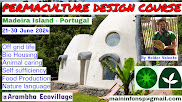New School Permaculture PDC
Permaculture Design Course
To see what we grow click HERE
To join us on Facebook click HERE
This course will be in the beautiful subtropical island of Tenerife.
This island has amazing microclimates, you can find plants from cold climates like chestnuts or rhubarb with tropical fruits like mangoes or pineaples all growing verry toguether.
Tenerife Island - Spain
2017
This course will be at a New School Permaculture designed farm.
Where you can see the Atlantis food forest garden concept in practice,
This course will be in the beautiful subtropical island of Tenerife.
This island has amazing microclimates, you can find plants from cold climates like chestnuts or rhubarb with tropical fruits like mangoes or pineaples all growing verry toguether.
What is Permaculture?
Permaculture is a sustainable design system that provides for human needs while having positive effects on the surrounding environment.
It is based on the ethics of earth care, people care and fair share, and provides practical solutions to the global crises we are currently facing.
Helder studied and worked with pioneers like Bill Mollison and Geoff Lawton in Turkey, Doug Bullock in the Amazon, Rosemary Morrow in Austria, Graham Bell in Scotland, Darren dougherty, Ernst Gotcsh, Sepp Holzer in Portugal and many others in countries like Haiti, Canada, Egipt, Finland, Peru, always learning and practicing this sustainable design methods.
While living in the city he dedicated 5 years on developing urban permaculture projects and for the last 5 years traveling and developing permaculture institutes around the world.
It all started in 2009 teaching permaculture to students at the agriculture university and since then learning and teaching in many different climates and getting to know the old ways and new ways of sharing information.
By December 2012 in the Peruvian Amazon working in support to the shipibo indigenous communities Helder created the New School Permaculture and is now developing alternative educational methods.
In 2013 the New School has been presenting at the IPC International Permaculture congress in Cuba
The New School Permaculture uses creative and inspiring educational tools that enable the students to empower each other in a way that many people have never experienced in their lives before.

To see testimonials from our students
click HERE
The course is presented by creative non formal education methods, that are based on creating a bridge between the right and left side of the brain, so that the analytical and creative abilities of the students get fully stimulated and get the most out of the experience...for many people is the most empowering and inspiring transformative process of their lives...and they carry this with them every were they go....and thats our goal.
To see what grows in the region
click HERE
The subjects covered during this Permaculture Design Course include:
The ethics and principles of Permaculture
Learning strategies
Educational Methods
Reading the landscape
Pattern in design
Biodiversity
Water preservation
Forests and trees
Soils building
Climates
Buildings and natural construction
Alternative economies
Community development
To know more about the content of the course you can check our videos on you tube
Event is also on facebook

Leave your questions or comments and subscribe.
Hope to see you with us on this adventure
En castellano
El curso sigue un plan de estudios conjunto y conduce al Certificado en Diseño de Permacultura internacionalmente reconocido.
Facilitado por Helder Valente y amigos de la Permacultura New School.
Helder estudió y trabajó con pioneros como Bill Mollison, Sepp Holzer, Doug Bullock, Rosemary Morrow, Darren dougherty, Ernst Gotsh y otros, y ahora enseña en todo el mundo.
Se inició en 2009 con la enseñanza de la permacultura a estudiantes en la Universidad Agrícola y desde entonces continúa el aprendizaje y la enseñanza en muchos climas diferentes.
Mientras vivía en la ciudad dedicó 3 años al desarrollo de un proyecto de permacultura urbana en el centro de Lisboa y co-creó el Instituto de Permacultura Portugués.
Así es como empezó todo.
Helder nunca se detuvo y estos últimos meses pasó su tiempo de trabajo con los agricultores quechuas en los Andes, el diseño de proyectos en la selva amazónica y ecoaldeas como Findhorn.
Muy recientemente, fue uno de los presentadores en el IPC Convergencia Internacional de Permacultura en La Habana Cuba
En esta oportunidad, el PDCse celebra en la hermosa isla subtropical de Tenerife (Islas Canarias – España), que cuenta con una variedad increíble de microclimas.
Los temas tratados durante este Curso de Diseño de Permacultura incluyen:
Ética y principios de la Permacultura
Estrategias de aprendizaje
El concepto de “Patrones” en el diseño
Biodiversidad
Conservación del agua
Producción de alimentos
Los bosques y los árboles
Contrucción de suelo
Climas
Edificios y construcciones naturales
Economías alternativas
Desarrollo comunitario
Los primeros tres días de este curso se pueden reservar como Curso Introductorio de Permacultura, o puede permanecer para el curso completo PDC.
INFO Contacto:
newschoolpermies(at)gmail.com
newschoolpermies(at)gmail.com






































